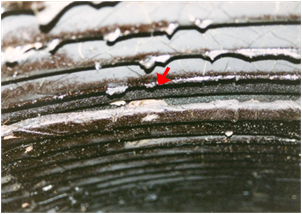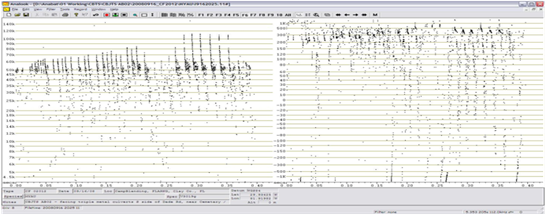
|
Fly By Night, Inc. is recognized by the IRS as a Section 501(c)(3) non-profit / tax-exempt organization. Donations are tax-deductible and all donated funds directly support our bat conservation efforts. CH12360
All content on this site is property of Fly By Night, Inc, and not to be duplicated for use without written permission |



Photo taken during central Florida survey. MYAU Anabat file recorded in Clay Co FL September 2008Red arrow points to MYAU roosting in culvert seam |
|
Southeastern Myotis, Myotis austroriparius austroriparius |
MYAUEcholocation: 50K Myotis. LF = 40 – 50, extending to 80K, stick shaped Florida Distribution: Disjunct populations north and central FL Roosting Behavior: Colonial. Males sometimes solitary. Buildings, bridges/, culverts, storm water drainage systems below roadways, tree cavities in or near mature swamps, caves. Sometimes roosts with TABR and NYHU. Individuals have been observed roosting with Corynorhinus & Pipistrellus (Finn unpublished). Foraging Behavior: Over and near water, flies low, just above surface. Midges, small moths and other small soft-bodied insects Reproduction: Twins born late April – mid May Management and Conservation Recommendations: due to its behavior of roosting in very large numbers during maternity season the population is considered at risk in the event a catastrophic event occurs at one of those roost sites. MYAU have been documented roosting in bridges, culverts , structures & bat houses. It was the most numerous species encountered during surveys at several sites in FL and GA. Education programs aimed at the public, installation of bat houses, conservation of forested wetlands and adjacent habitat, preservation of cavity trees and protection of culverts that are occupied by roosting bats will benefit this and other bat species. |
|
Free Info |
|
What We Do |
|
Who We Are |
|
How To Help |
|
Take A Peek |
|
Live Bats |
|
Urban Bat Status |
|
Buildings |
BatHouses |
|
Yes |
Yes |
|
Status |
|||
FWS / USGS |
Florida |
FNAI |
IUCN |
|
Former C2 / SAR |
S3 Vulnerable |
G3/G4 |
LC |
|
Status & distribution under review by USFWS (Dec 2008). |
|||
|
Description—Measurements |
|||||
|
Mass g |
FA mm |
Wingspan |
Total length |
Tragus |
Calcar |
|
5 – 8 |
35 – 22 |
238 – 270 |
82 – 87 |
½ length of ear, pointed |
not keeled |
|
Gray to reddish with lighter underside, long hairs on toes |
|||||

